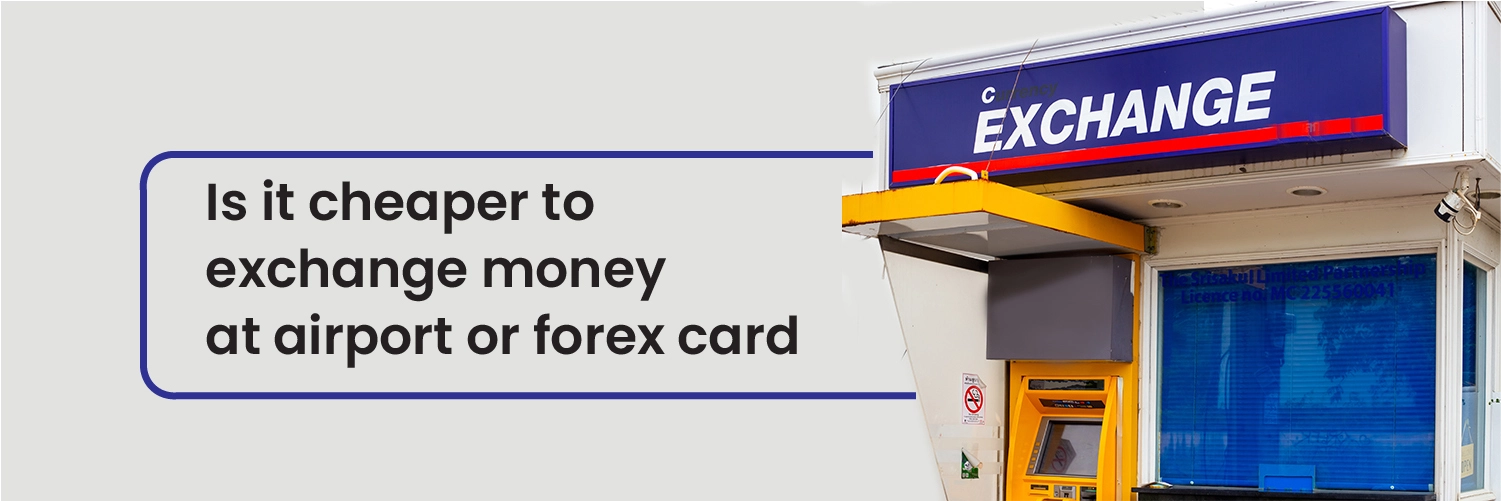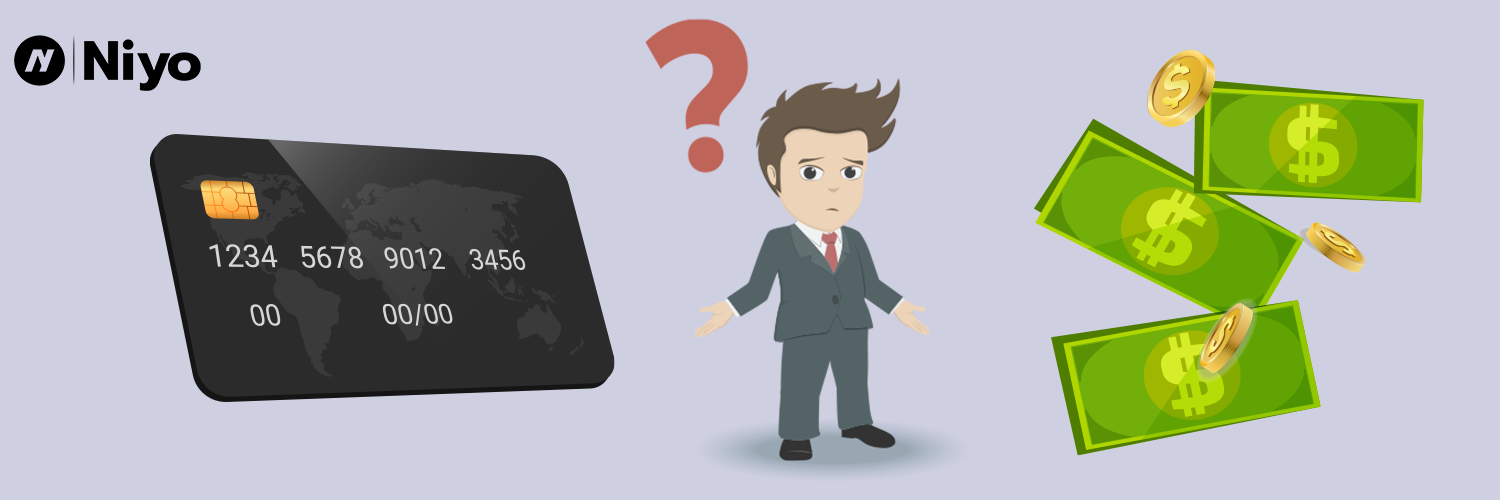
Exchange Money at Airport : Tips for Indians
A comparison between airport currency exchange and Forex cards to help travellers choose the more cost-effective and convenient option. Highlights the limitations of Forex cards and introduces international debit cards as a smarter alternative for managing money abroad.
Is It Cheaper to Exchange Money at the Airport or Use a Forex Card?
As a traveller, is it better to carry cash or a Forex card? This question might have popped up in your mind often. It is true yet hard to understand whether exchanging money at the airport or using a Forex card is cheaper.
While planning a vacation, you need to ensure you enjoy a hassle-free trip without stress. So, the primary and most crucial step is money management. Now, there are various ways by which you can exchange money, but you need to make sure that the process you choose is less complicated. It should be economical with no/less currency exchange rates and widely accepted.
Exchanging Money At the Airport
Exchanging currency at the airport is a common practice followed globally, but it is an expensive approach. Did you know airport currency exchange rates are high? They charge you between 10%-12% more than the value of the amount. Airport currency exchanges come with extra fees and whopping exchange charges. It is better to take advantage of international travel cards or credit cards to avoid High currency exchange rates at the Airport. Therefore, before exchanging currency, get to know the airport currency exchange rate and decide.
Pros:
- Immediate access: No waiting for delivery, grab your cash and hit the ground running.
- Physical security: Carrying some local currency can bring peace of mind, especially when cards aren’t accepted.
Cons:
- Exorbitant rates: Airports notoriously offer the worst exchange rates, often with hidden fees buried in the fine print. You could be paying up to 15% more than the market rate!
- Limited options: You’re stuck with whatever rates the single bureau offers, no comparison shopping allowed.
Using a Forex Card
A Forex card is a popular alternative to airport exchange. A Forex card functions just like a debit card and is easy to use. You can use a Forex card at ATMs or stores. It transfers money between your Forex account and the ATM or store.
If you decide to use a Forex card to buy anything, you can buy it in the currency loaded on your card. Since a Forex card is pre-loaded with the currency of your destination country, you don’t have to worry about the exchange rate; you can get what you pay for. Moreover, these conversion charges are lesser than airport conversion charges.
Using a Forex card ensures you have ample money to make purchases every time in whichever country you travel to. Further, it gives you access to global markets. Purchasing items in different currencies gives you more freedom and flexibility when purchasing from other countries. You will lose out on this benefit if you spend extra on conversion fees when you convert currency at the airport.
Security checkpoints at airports are getting strict, which means there will be less of an opportunity to get through security with a bag full of money. Getting a Forex card to withdraw your money at an ATM in the country you travel to could save time when checking in at the airport. But beware that Forex cards can charge hefty ATM withdrawal fees.
Forex cards are safer than carrying cash, and with cash, you have the added danger of being robbed. A Forex card requires both an electronic signature and PIN used to authorise each transaction made on the account, which means you have even more protection against unauthorised use of your money. This won’t be the case if you exchange money at the airport. A Forex debit card is accepted pretty much anywhere that Visa or Mastercard are accepted, just about anywhere in the world.
Pros:
- Competitive rates: Advantage of Forex cards is generally offer rates closer to the interbank market rate, significantly cheaper than airport exchanges.
- Convenience: Load multiple currencies, track spending, and avoid carrying bulky cash.
- Safety: Cards come with chip-and-PIN security and loss protection, minimising theft risk.
Cons:
- Advance planning: You need to order your card beforehand, leaving no room for last-minute decisions.
- Transaction fees: Some cards charge small per-transaction fees, which are often lower than airport markups.
- Acceptance: While widely accepted, cards might not work everywhere, especially in remote areas.
- ATM Withdrawal Charges: One of the major disadvantages of Forex cards is the ATM withdrawal charges. You might have to pay $US2 to $US3 for each ATM withdrawal. You might also have to pay cross-currency charges up to 3%.
- Tax: You must also pay a cross-currency tax of up to 0.18% for less than 1 lakh.
- Limited Validity: Most Forex cards also have a limited validity of 1 year, which can be problematic if you are a frequent traveller.
Cost Comparison: Currency Exchange vs Forex Card
| Exchange Amount | Airport Exchange (Estimated Total Cost) | Forex Card (Estimated Total Cost) | Cost Difference |
| $100 | $110-$115 | $102-$105 | $5-$10 |
| $500 | $555-$565 | $510-$515 | $40-$50 |
| $1000 | $1110-$1120 | $1020-$1025 | $90-$95 |
As the table shows, airport exchange is consistently more expensive than a Forex card. The cost difference grows with the exchange amount, making Forex cards a clear winner for larger sums. Even for smaller amounts, the convenience and security of a Forex card often outweigh the marginal cost savings of airport exchange.
All these factors can make it more sensible to look for better payment methods like Niyo. There is no issuance charge associated with Niyo Global. You don’t have to pay any loading or unloading charges. Instead, you can get up to 7.5% interest on the balance amount you don’t spend. You also don’t have to pay any Forex markup fees on your international transactions, which is one of the major reasons why Niyo is a better payment option than Forex cards.
Why prefer a Niyo Card over Forex Cards?
Niyo has simplified and revolutionised the banking experience for its customers through its Niyo Card. The Niyo Card is your one-stop travel payment solution. It is an Indian Rupee-based international debit card linked to an interest-earning account and a smart app that helps you to make payments in more than 150 countries. You can load your Niyo card with Indian Rupees and spend it in any currency you want. The card auto-converts the currency at 0% Forex markup value. It means the Niyo card doesn’t charge any extra fees for providing the convenience of making payments in a foreign currency. Apart from that, you get complimentary airport lounge access, so you can relax and rejuvenate before your flight.
Other features of the Niyo card include:
- Zero Forex markup
- Up to 7.5% interest on your savings with monthly interest payouts
- Free airport lounge access across India
- Add money in INR and use in 150+ countries & 130+ currencies
- Customer Service is available in-app 24X7
- Tap and Pay transactions
- Quick ATM Locator within the app
- Handy foreign currency converter within the app
- There are no account opening fees
- The account opening process is 100% digital within the app, no need to visit the bank
- There are no fees for non-maintenance on the Zero Balance Card
- You can easily add money using UPI/NEFT/IMPS without any charges
- Niyo app allows you to manage your payment limit across multiple payment channels
Key Takeaways
Forex cards can be a good option for making an international payment, but they lag in many areas where international debit cards easily excel. Therefore, it’s best to look for better alternative payment options that do not charge hefty fees as Forex cards do. International debit cards like Niyo offer obvious benefits over Forex cards, which makes them a preferred choice over Forex cards for international travellers.



